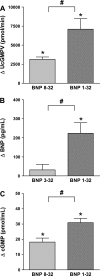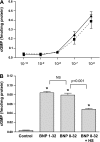B-type natriuretic peptide 8-32, which is produced from mature BNP 1-32 by the metalloprotease meprin A, has reduced bioactivity
- PMID: 19386989
- PMCID: PMC2692783
- DOI: 10.1152/ajpregu.00059.2009
B-type natriuretic peptide 8-32, which is produced from mature BNP 1-32 by the metalloprotease meprin A, has reduced bioactivity
Abstract
32-amino acid B-type natriuretic peptide (BNP 1-32) plays an important role in cardiovascular homeostasis. Recently, it was reported that BNP 1-32 is cleaved by the metalloprotease meprin A to BNP 8-32, the bioactivity of which is undefined. We hypothesized that BNP 8-32 has reduced vasodilating and natriuretic bioactivity compared with BNP 1-32 in vivo. Human BNP 8-32 and BNP 1-32 were compared in a crossover study in eight anesthetized normal canines. After a preinfusion clearance, BNP 1-32 was infused at 30 ng.kg(-1) x min(-1) for 45 min followed by a 60-min washout and a second preinfusion clearance. Then, equimolar BNP 8-32 was infused. In half of the studies, the peptide sequence was reversed. Changes with peptides from the respective preinfusion clearance to infusion clearance were compared with paired tests. Mean arterial pressure was reduced by both BNP 8-32 and BNP 1-32 (-8 +/- 3 vs. -6 +/- 2 mmHg, P = 0.48). Changes in right atrial pressure, pulmonary capillary wedge pressure, heart rate, cardiac output, and glomerular filtration rate were similar. However, urinary sodium excretion increased less with BNP 8-32 than with BNP 1-32 (+171 +/- 24 vs. +433 +/- 43 muEq/min; P = 0.008), as did urinary potassium excretion, urine flow, and renal blood flow. While BNP 8-32 has similar vasodilating actions as BNP 1-32, its diuretic and natriuretic actions are reduced, suggesting a role for meprin A in the regulation of BNP 1-32 bioactivity in the kidney. Meprin A inhibition may be a potential strategy to increase the bioactivity of endogenous and exogenous BNP 1-32 in cardiovascular diseases.
Figures




Similar articles
-
Des-serine-proline brain natriuretic peptide 3-32 in cardiorenal regulation.Am J Physiol Regul Integr Comp Physiol. 2007 Feb;292(2):R897-901. doi: 10.1152/ajpregu.00569.2006. Epub 2006 Oct 26. Am J Physiol Regul Integr Comp Physiol. 2007. PMID: 17068158
-
Brain natriuretic peptide enhances renal actions of furosemide and suppresses furosemide-induced aldosterone activation in experimental heart failure.Circulation. 2004 Apr 6;109(13):1680-5. doi: 10.1161/01.CIR.0000124064.00494.21. Epub 2004 Mar 15. Circulation. 2004. PMID: 15023890
-
Selective endothelin B receptor blockade does not influence BNP-induced natriuresis in man.Kidney Int. 2006 Mar;69(5):864-8. doi: 10.1038/sj.ki.5000215. Kidney Int. 2006. PMID: 16518347 Clinical Trial.
-
The renal paracrine peptide system--possible urologic implications of urodilatin.World J Urol. 1996;14(6):375-9. doi: 10.1007/BF00183118. World J Urol. 1996. PMID: 8986039 Review.
-
Dipeptidyl-peptidase IV and B-type natriuretic peptide. From bench to bedside.Clin Chem Lab Med. 2009;47(3):248-52. doi: 10.1515/CCLM.2009.065. Clin Chem Lab Med. 2009. PMID: 19327104 Review.
Cited by
-
BNP molecular forms and processing by the cardiac serine protease corin.Adv Clin Chem. 2013;61:1-31. doi: 10.1016/b978-0-12-407680-8.00001-4. Adv Clin Chem. 2013. PMID: 24015598 Free PMC article. Review.
-
Design, Synthesis, and Actions of an Innovative Bispecific Designer Peptide.Hypertension. 2019 Apr;73(4):900-909. doi: 10.1161/HYPERTENSIONAHA.118.12012. Hypertension. 2019. PMID: 30798663 Free PMC article.
-
Modulation of cGMP in heart failure: a new therapeutic paradigm.Handb Exp Pharmacol. 2009;(191):485-506. doi: 10.1007/978-3-540-68964-5_21. Handb Exp Pharmacol. 2009. PMID: 19089342 Free PMC article. Review.
-
The metalloproteases meprin α and meprin β: unique enzymes in inflammation, neurodegeneration, cancer and fibrosis.Biochem J. 2013 Mar 1;450(2):253-64. doi: 10.1042/BJ20121751. Biochem J. 2013. PMID: 23410038 Free PMC article. Review.
-
Human B-type natriuretic peptide is not degraded by meprin A.Biochem Pharmacol. 2010 Oct 1;80(7):1007-11. doi: 10.1016/j.bcp.2010.06.015. Epub 2010 Jun 23. Biochem Pharmacol. 2010. PMID: 20599787 Free PMC article.
References
-
- Abraham WT, Lowes BD, Ferguson DA, Odom J, Kim JK, Robertson AD, Bristow MR, Schrier RW. Systemic hemodynamic, neurohormonal, and renal effects of a steady-state infusion of human brain natriuretic peptide in patients with hemodynamically decompensated heart failure. J Card Fail 4: 37–44, 1998. - PubMed
-
- Ban K, Noyan-Ashraf MH, Hoefer J, Bolz SS, Drucker DJ, Husain M. Cardioprotective and vasodilatory actions of glucagon-like peptide 1 receptor are mediated through both glucagon-like peptide 1 receptor-dependent and -independent pathways. Circulation 117: 2340–2350, 2008. - PubMed
-
- Boerrigter G, Costello-Boerrigter LC, Harty GJ, Lapp H, Burnett JC Jr. Des-serine-proline brain natriuretic peptide 3-32 in cardiorenal regulation. Am J Physiol Regul Integr Comp Physiol 292: R897–R901, 2007. - PubMed
-
- Brandt I, Lambeir AM, Ketelslegers JM, Vanderheyden M, Scharpe S, De Meester I. Dipeptidyl-peptidase IV converts intact B-type natriuretic peptide into its des-SerPro form. Clin Chem 52: 82–87, 2006. - PubMed
-
- Carmago S, Shah SV, Walker PD. Meprin, a brush-border enzyme, plays an important role in hypoxic/ischemic acute renal tubular injury in rats. Kidney Int 61: 959–966, 2002. - PubMed
Publication types
MeSH terms
Substances
Grants and funding
LinkOut - more resources
Full Text Sources
Miscellaneous

